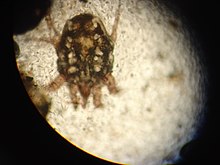| Psoroptes | |
|---|---|
 | |
| Psoroptes cuniculi | |
| Scientific classification | |
| Domain: | Eukaryota |
| Kingdom: | Animalia |
| Phylum: | Arthropoda |
| Subphylum: | Chelicerata |
| Class: | Arachnida |
| Order: | Sarcoptiformes |
| Family: | Psoroptidae |
| Genus: | Psoroptes Gervais, 1841 |
| Species: | P. equi |
| Binomial name | |
| Psoroptes equi (Hering, 1838) | |
| Synonyms | |
| |
Psoroptes is a genus of mites, including the agents that cause psoroptic mange.